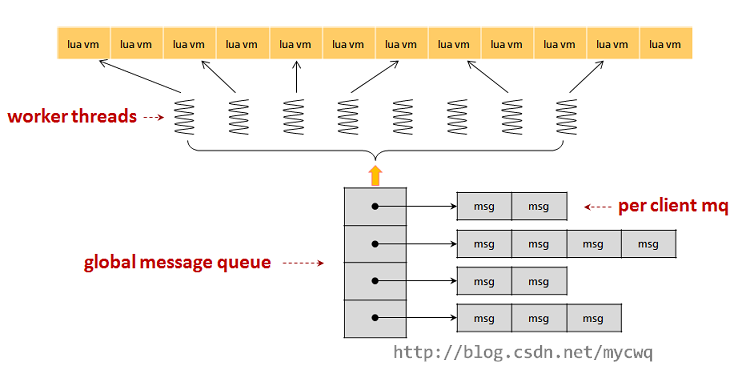skynet服务的设计
统观整篇文章,不难发现:
每个skynet服务都是一个lua state,也就是一个lua虚拟机实例。而且,每个服务都是隔离的,各自使用自己独立的内存空间,服务之间通过发消息来完成数据交换。
架构图如下:
图片取自spartan1的skynet任务调度分析
lua state本身没有多线程支持的,为了实现cpu的摊分,skynet实现上在一个线程运行多个lua state实例。而同一时间下,调度线程只运行一个服务实例。为了提高系统的并发性,skynet会启动一定数量的调度线程。同时,为了提高服务的并发性,就利用lua协程并发处理。
所以,skynet的并发性有3点:
1、多个调度线程并发
2、lua协程并发处理
3、服务调度的切换
skynet服务的设计基于Actor模型。有两个特点:
1. 每个Actor依次处理收到的消息
2. 不同的Actor可同时处理各自的消息
skynet服务的缺陷
并发问题
这要从skynet一个服务霸占调度器的极端例子说起。
下面给出两个lua代码 main.lua 和 simpledb.lua,和一个配置文件 config
- -- main.lua
- local skynet = require "skynet"
- skynet.start(function()
- print("Server start")
- skynet.newservice("simpledb")
- -- 发消息给simpledb服务
- skynet.send("SIMPLEDB", "lua", "TEST")
- -- 死循环占据cpu
- local i = 0
- while true do
- i = i>100000000 and 0 or i+1
- if i==0 then
- print("I'm working")
- end
- end
- skynet.exit()
- end)
-- main.lua
local skynet = require "skynet"
skynet.start(function()
print("Server start")
skynet.newservice("simpledb")
-- 发消息给simpledb服务
skynet.send("SIMPLEDB", "lua", "TEST")
-- 死循环占据cpu
local i = 0
while true do
i = i>100000000 and 0 or i+1
if i==0 then
print("I'm working")
end
end
skynet.exit()
end)
- -- simpledb.lua
- local skynet = require "skynet"
- require "skynet.manager" -- import skynet.register
- local db = {}
- local command = {}
- function command.TEST()
- print("Simpledb test")
- return true
- end
- skynet.start(function()
- print("Simpledb start")
- skynet.dispatch("lua", function(session, address, cmd, ...)
- local f = command[string.upper(cmd)]
- if f then
- skynet.ret(skynet.pack(f(...)))
- else
- error(string.format("Unknown command %s", tostring(cmd)))
- end
- end)
- skynet.register "SIMPLEDB"
- end)
-- simpledb.lua
local skynet = require "skynet"
require "skynet.manager" -- import skynet.register
local db = {}
local command = {}
function command.TEST()
print("Simpledb test")
return true
end
skynet.start(function()
print("Simpledb start")
skynet.dispatch("lua", function(session, address, cmd, ...)
local f = command[string.upper(cmd)]
if f then
skynet.ret(skynet.pack(f(...)))
else
error(string.format("Unknown command %s", tostring(cmd)))
end
end)
skynet.register "SIMPLEDB"
end)配置文件 config
- root = "./"
- thread = 1
- logger = nil
- logpath = "."
- harbor = 1
- address = "127.0.0.1:2526"
- master = "127.0.0.1:2013"
- start = "main"
- bootstrap = "snlua bootstrap"
- standalone = "0.0.0.0:2013"
- luaservice = root.."service/?.lua;"..root.."test/?.lua;"..root.."examples/?.lua"
- lualoader = "lualib/loader.lua"
- snax = root.."examples/?.lua;"..root.."test/?.lua"
- cpath = root.."cservice/?.so"
root = "./" thread = 1 logger = nil logpath = "." harbor = 1 address = "127.0.0.1:2526" master = "127.0.0.1:2013" start = "main" bootstrap = "snlua bootstrap" standalone = "0.0.0.0:2013" luaservice = root.."service/?.lua;"..root.."test/?.lua;"..root.."examples/?.lua" lualoader = "lualib/loader.lua" snax = root.."examples/?.lua;"..root.."test/?.lua" cpath = root.."cservice/?.so"
注意了,这里特地把 thread 设置为1,表示只启动一个调度线程。
现在,启动skynet执行我们的例子,结果如下:|
[root@local skynet]# ./skynet config [:01000001] LAUNCH logger [:01000002] LAUNCH snlua bootstrap [:01000003] LAUNCH snlua launcher [:01000004] LAUNCH snlua cmaster [:01000004] master listen socket 0.0.0.0:2013 [:01000005] LAUNCH snlua cslave [:01000005] slave connect to master 127.0.0.1:2013 [:01000004] connect from 127.0.0.1:41589 4 [:01000006] LAUNCH harbor 1 16777221 [:01000004] Harbor 1 (fd=4) report 127.0.0.1:2526 [:01000005] Waiting for 0 harbors [:01000005] Shakehand ready [:01000007] LAUNCH snlua datacenterd [:01000008] LAUNCH snlua service_mgr [:01000009] LAUNCH snlua main Server start [:0100000a] LAUNCH snlua simpledb Simpledb start I'm working I'm working I'm working |
这和skynet的调度机制有关。skynet使用全局队列保存了要调度的服务,调度算法是先来先服务。如果某个服务有新消息,就把这个服务加到调度队列中,然后等待调度线程调度。而skynet服务的调度切换依赖于协程的挂起,如果当前调度的服务没有主动挂起或退出,就会一直执行,不调度其他服务了。
这种机制的好处就是实现简单,有利于长作业,上下文切换较少,缺点就是并发效率低,而且像这种长作业的服务超过调度线程数量,就可能导致其他服务饿死。内存隐患
细心的同学会发现,在服务处理新消息时,是通过创建新协程来处理的(见co_create),虽然协程会被重复利用,但在当前版本下,这种不断创建协程来消息的方式本身存在不稳定因素:
1、协程只增加不减少,意味过了某个并发高峰后内存不会降下来。
2、创建协程也有一定开销,容易触发GC,也占用内存,协程的数量规模不容易控制
3、如果解决第1点,最槽糕的情况是,不断要创建协程,不断要销毁协程,频繁触发gc
这里有一个极端的例子:
如果服务a不断给服务b发消息,但服务b的处理过程存在长时间挂起,这样,对于服务a发来的消息,服务b会不断创建协程去处理,就导致内存被大量占用的情况出现。
但是skynet也提供办法解决这个问题,方法是主动调用GC:
- skynet.send(service,"debug","GC")
skynet.send(service,"debug","GC")
另外,有兴趣的同学,不妨看下实现代码:
- -- debug.lua
- return function (skynet, export)
- -- 处理 GC 消息
- function dbgcmd.GC()
- export.clear() -- export 是 skynet.debug 的传入参数
- collectgarbage "collect" -- 执行GC
- end
- local function _debug_dispatch(session, address, cmd, ...)
- local f = (dbgcmd or init_dbgcmd())[cmd] -- lazy init dbgcmd
- f(...)
- end
- skynet.register_protocol {
- name = "debug", -- 注册处理服务收到的 "debug" 消息
- id = assert(skynet.PTYPE_DEBUG),
- pack = assert(skynet.pack),
- unpack = assert(skynet.unpack),
- dispatch = _debug_dispatch,
- }
- end
-- debug.lua
return function (skynet, export)
-- 处理 GC 消息
function dbgcmd.GC()
export.clear() -- export 是 skynet.debug 的传入参数
collectgarbage "collect" -- 执行GC
end
local function _debug_dispatch(session, address, cmd, ...)
local f = (dbgcmd or init_dbgcmd())[cmd] -- lazy init dbgcmd
f(...)
end
skynet.register_protocol {
name = "debug", -- 注册处理服务收到的 "debug" 消息
id = assert(skynet.PTYPE_DEBUG),
pack = assert(skynet.pack),
unpack = assert(skynet.unpack),
dispatch = _debug_dispatch,
}
end
而什么时候调用了 skynet.debug 呢?看这里
- -- skynet.lua
- local function clear_pool()
- coroutine_pool = {} -- 清空协程的引用
- end
- -- debug设置回调处理函数
- local debug = require "skynet.debug"
- debug(skynet, {
- dispatch = skynet.dispatch_message,
- clear = clear_pool,
- suspend = suspend,
- })
-- skynet.lua
local function clear_pool()
coroutine_pool = {} -- 清空协程的引用
end
-- debug设置回调处理函数
local debug = require "skynet.debug"
debug(skynet, {
dispatch = skynet.dispatch_message,
clear = clear_pool,
suspend = suspend,
})
就是说,但给服务发送GC消息时,就会清空协程池,随后执行底层GC接口。这样,不再有内容引用到这个协程,所以,协程会在GC时被清理。
至于协程只是挂起没有结束,为什么会被清理?
因为从协程池移走后,那些协程就变成了不可达的协程了,没有方法能 coroutine.resume 激活他们了,所以就会被gc掉。
同步问题
同步也是skynet存在的问题,当一个服务call其他服务时,当前协程会挂起,但是这个服务还可以接受并处理其他消息。如果多个协程改到同一个数据,你不做同步处理就无法确定这个数据会是多少。
这样的例子特别常见,比如,服务正当处理玩家login请求,刚好遇到call挂起,这时候又有新的请求到来,比如logout,服务就会转去处理logout消息。那玩家究竟是login,还是logout?
参考:http://blog.csdn.net/mycwq/article/details/47379277
